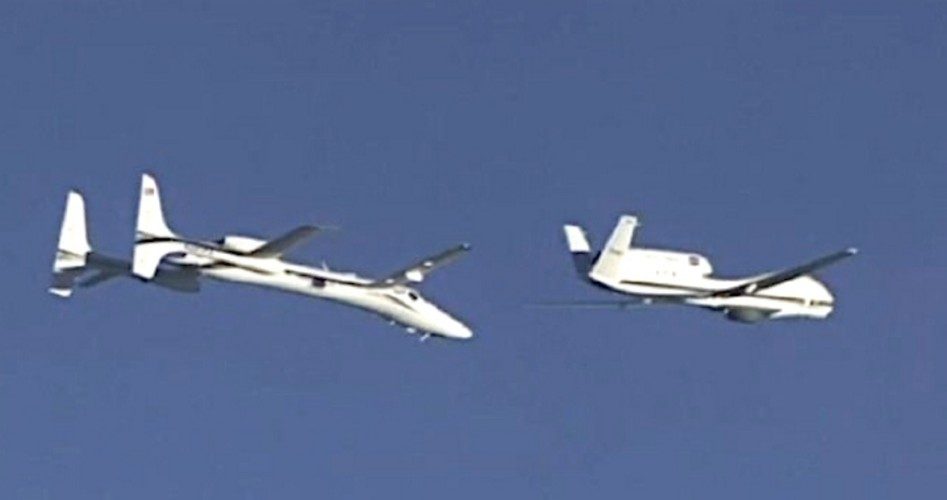
Defense contractor Northrop Grumman, the Defense Advanced Research Projects Agency (DARPA), and NASA Dryden Flight Research Center reported on October 8 that they are moving closer to the day when drones can stay airborne indefinitely, refueled by other unmanned aerial vehicles without human assistance.
The test flights conducted between January 11 and May 30 involved the use of two Global Hawk drones — “one configured as a tanker and the other as a receiver.” The experiments were conducted at Edwards Air Force Base, California and reportedly resulted in the achieving of many milestones:
The lead receiver aircraft extended and retracted its aerial refueling hose several times, completing all planned tests to validate the associated program hardware and software.
The trail tanker aircraft successfully demonstrated precision control in formation with manual and automated “breakaway” maneuvers — important safety features and criteria of the test program.
Two Global Hawk unmanned aircraft successfully flew for the first time in close formation — as close as 30 feet.
During the close-formation flight, the aircraft rendezvoused and flew for more than 2.5 hours under autonomous formation control, with the majority of the time within 100 ft (or one wingspan) of each other.
“The technical developments that enabled these two high-altitude, long-endurance unmanned Global Hawks in close formation is an outstanding accomplishment for the AHR [Autonomous High-altitude Refueling] program,” said Fred Ricker, vice president and deputy general manager for Northrop Grumman Aerospace Systems’ Advanced Programs & Technology. “Coupled with the advanced design and technical implementation of aerial refueling systems on board both aircraft, the demonstration has truly brought a concept to life, which has the potential to change the operations for unmanned aircraft utility and enable mission flexibility never before realized.”
A DARPA news release reported on the success of the $33-million program:
During its final test flight, two modified Global Hawk aircraft flew in close formation, 100 feet or less between refueling probe and receiver drogue, for the majority of a 2.5-hour engagement at 44,800 feet. This demonstrated for the first time that High Altitude Long Endurance (HALE) class aircraft can safely and autonomously operate under in-flight refueling conditions. The flight was the ninth test and the first time the aircraft flew close enough to measure the full aerodynamic and control interactions. Flight data was analyzed over the past few months and fed back into simulations to verify system safety and performance through contact and fuel transfer — including the effects of turns and gusts up to 20 knots.
This is very promising for the perpetuation of the death-by-drone program and for its expansion domestically in the coming years. The Federal Aviation Administration (FAA) predicts that by 2020, 30,000 of these unmanned aerial vehicles (UAV) will be patrolling American airspace.
DARPA program manager Jim McCormick seems to hint at the wide range of uses to which such advanced drones may be put in the near future.
“The goal of this demonstration was to create the expectation that future HALE aircraft will be refueled in flight,” McCormick said. “Such designs should be more affordable to own and operate across a range of mission profiles than systems built to satisfy the most stressing case without refueling. The lessons from AHR certainly extend beyond the HALE flight regime, and insights into non-traditional tanker concepts may offer further operational advantages.”
If, as McCormick predicts, this new military technology will make drones more affordable and more easily operated, the deployment of them domestically may pose a legitimate threat to the privacy and liberty of Americans as law enforcement agencies purchase squadrons of the vehicles in the years to come.
Such a deployment will create several critical questions of constitutionality of their potential uses — the most crucial being the application of the Fourth Amendment’s prohibition against “unlawful searches and seizures” and the requirement that warrants be supported by affidavits “particularly describing the place to be searched, and the persons or things to be seized. ”To shore up the strength of this constitutional barrier, in June Senator Rand Paul introduced a bill to “protect individual privacy against unwarranted governmental intrusion through the use of unmanned aerial vehicles commonly called drones.” Paul’s bill mandates: “A person or entity acting under the authority [of], or funded in whole or in part by, the Government of the United States shall not use a drone to gather evidence or other information pertaining to criminal conduct or conduct in violation of a statute or regulation except to the extent authorized in a warrant that satisfies the requirements of the Fourth Amendment to the Constitution of the United States.”
Senator Paul explained, “Americans going about their everyday lives should not be treated like criminals or terrorists and have their rights infringed upon by military tactics.”
Constitutional conflicts rising in the wake of the domestic deployment of drones have already come up in court in the case of Rodney Brossart, who became one of the first American citizens (if not the first) arrested by local law enforcement with the use of a drone owned by a federal agency. Police launched this loaner after Brossart held the police at bay for over 16 hours.
Brossart’s run-in with law enforcement began after six cows found their way onto his property (about 3,000 acres near Lakota, North Dakota), and he refused to turn them over to officers. In fact, according to several sources, Brossart and a few family members ran police off his farm at the point of a gun. Naturally, police weren’t pleased with Brossart’s brand of hospitality, so they returned with a warrant, a SWAT team, and a determination to apprehend Brossart and the cows.
A standoff ensued, and the Grand Forks police SWAT team made a call to Grand Forks Air Force Base, home to one of the Department of Homeland Security’s squadron of Predator drones. No sooner did the call come in than the drone was airborne, and Brossart’s precise location was pinpointed with laser-guided accuracy. The machine-gun toting SWAT officers rushed in, tased, and then arrested Brossart on various charges, including terrorizing a sheriff.
At a legal hearing on the matter, Bruce Quick, the lawyer representing Brossart, alleged a violation of the Fourth Amendment’s protection against unwarranted searches and seizures. Although the police possessed an apparently valid search warrant, Quick asserts that no such judicial go-ahead was sought for or obtained for the use of the Predator drone to track Brossart. Therein lies the constitutional rub.
Senator Paul’s measure, if enacted, would give specific guidance to the judicial branch’s understanding of the Fourth Amendment and the scope of its prohibitions. It would prevent citizens from being subject to surveillance without notice.
In practice, this would help judges apply the principles of the Fourth Amendment to drones in a very specific way. The standards presently used to judge the constitutionality of observation by helicopter or patrol car, for example, would be altered appropriately to fit the rapidly advancing drone technology. The improved legal framework would help law enforcement avoid legally suspect surveillance and would maintain the public’s protection against unconstitutional searches and seizures.
Another important consideration is what level of weaponization is permissible for the police? Does local law enforcement need the type of weaponry used by the military, whose mission is very different from that of law enforcement?
In fairness, there are many lawful possible uses of drones, including wildfire control, tracking suspected criminals for whom a qualifying warrant has been issued, tracking of stolen vehicles, etc. It is the unconstitutional use of drones that is objectionable and that Americans must be vigilant against.
According to the most recent figures, Northrop Grumman has contributed over $2 million to candidates’ campaign coffers, including $49,017 to President Barack Obama and $34,350 to Republican challenger Mitt Romney.
Photo: Northrop Grumman press release


